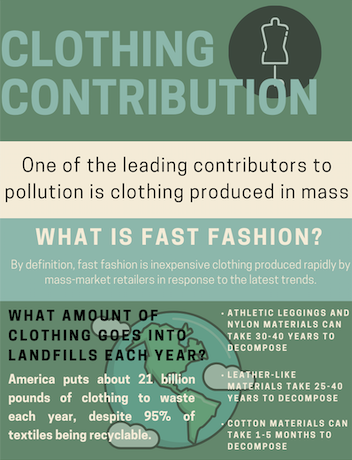Fateful fabrics
Fast fashion is killing the planet

Although many people are conscious about recycling and reducing plastic waste, it is not as known that clothing is a leading contributor to pollution and climate change.
November 8, 2019
The issue of climate change has caused more people to become as sustainable as possible. Whether it be by recycling, reducing plastic waste or eliminating meat from their diet. Yet, one of the leading contributions to air, water and soil pollution is something we use every day, but may be unaware of the damage: clothing.
From the sweatshops to the millions of tons of clothing that end up in the landfill each year, the fashion industry is one of the leading causes of pollution. Not only are most factories unsafe for their workers, but the compensation for what they do is minuscule. Many brands have taken advantage of the price the clothing is made at and sell it in mass quantities. This is known as fast fashion.
Fast fashion brands overproduce cheaply made clothing to ensure the maximum amount of income. These brands include Forever 21, TopShop, GAP and the biggest contenders, H&M and Zara. While these brands do follow the style of the season and are very affordable, they stock way more items than they will sell. All of the excess unsellable clothing ends up in the landfill, where it could take years to decompose. Along with this overabundance are all of the clothes that ended up tearing, washed out or out of season. According to Remake, a nonprofit that specializes in bringing awareness to the alternate side of the fashion industry, each year, the US alone puts about 21 billion pounds of clothing to waste.
For youth, these fast-fashion brands are so appealing because of their affordability. At Forever 21 a shirt may cost $5-$15. Consumers can buy the maximum amount of clothing for cheap. But anyone who has purchased from or even walked into a Forever 21 or any brand similar can tell how cheap the clothes are made. Fabrics are itchy and one snag on one’s brand new pair of pants means a colossal hole.
In addition, factories that produce mass clothing do not have the earth’s best interest in mind. According to EKOenergy, nylon and polyester produce a greenhouse gas, nitrous oxide, which damages the ozone layer when being manufactured. In addition, both fabrics break down when washed which leads to the buildup of microplastics in water. According to the Student Environmental Resource Center at the University of California Berkeley, 90% of cotton is genetically modified meaning it heavily relies on chemicals and pesticides contaminate water sources and soil. Dyes for clothing also have harmful chemicals that usually end up in natural resources. On the contrary, linen, hemp, organic cotton and recycled fabrics are the most sustainable fabrics and will likely withstand for a longer duration of time compared to the man-made fabrics.
Of course, the obvious solution to this is to buy nicer, well-made clothing. But that comes with a price that many are not willing to pay. Fortunately, there are cheaper ways to build a sustainable closet.
If it seems impossible to stray away from that one favorite fast-fashion brand, the solution is to simply find basics that will last. Fashion changes on a monthly basis. One style is in, the other is out. That is how clothes end up in the trash. To avoid this, only purchase basic articles of clothing. A black shirt or denim jacket is much more affordable at H&M than it is at Gucci, so it’s understandable to go with the cheaper option. Along with this, pay attention to fabrics to ensure what is bought will last. Whether it’s expensive or not, consumers want to get the most bang for their buck.
Second-hand stores and thrift shops are other great options to dress sustainably. There are Goodwills all across America, so it’s easier than it sounds. There are more trendy second-hand stores too for a more fashionable approach. Scout Dry Goods in Dundee is one of my favorites. They take specific clothing for the season to be sure it is in fashion. Not only is a place to buy clothes, but one can sell them too. Plato’s Closet is similar to Scout but on a larger spectrum. Not only do buyers get the maximum use of certain articles of clothing, but it’s a good way to find unique articles of clothing. Buyers are not only helping to save the planet, but they’re looking stylish as well.
Not contributing to fast-fashion brands will help reduce the amount of waste humans put out. As climate change has become a hot topic, more people are educated on how to do their part in helping the planet. When shopping, keep in mind the contribution made to the earth. Think about who made the clothes and how well-made they are. Clothes are a necessity for humans, but it is so simple to shop consciously and sustainably. Shop smart with the earth in mind.






